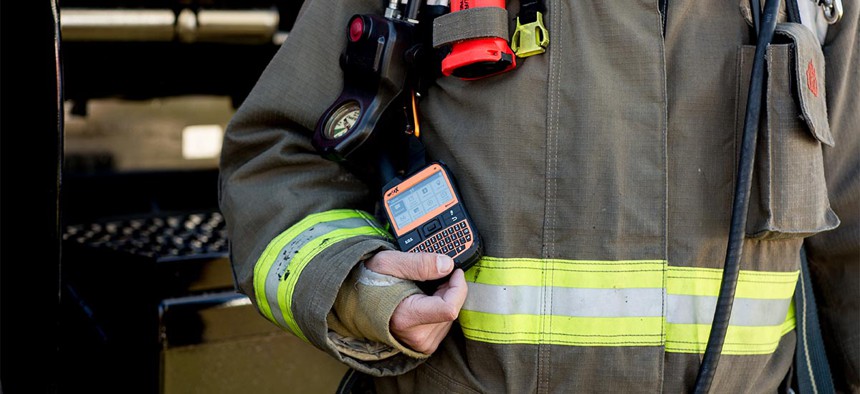sponsor content What's this?
Technology Fuels Efforts to Quell Wildfires at OCR 2019

Firefighters at OCR 2019 make use of several technologies to manage response. Verizon
Presented by
Verizon

As wildfires ravage different parts of the country, a demonstration at Operation Convergent Response 2019 shows how coordinated efforts fueled by technology can help first responders on the ground tackle a blazing inferno.
2018 saw the deadliest and most devastating wildfires in California’s history. In the Sierra Nevada foothills, the entire town of Paradise burned to ashes, leaving 11,000 people homeless. Up north, residents of Los Angeles and Ventura Counties watched as 95,000 acres and 1,500 structures went up in flames. And in California's Central Valley, the Camp Fire claimed 85 lives — and became the most expensive natural disaster that year.
With that backdrop, Verizon and Nokia brought attendees of Operation Convergent Response (OCR) 2019 to a simulated wildfire scenario, which showcased real-life response from firefighters and emergency personnel.
The scenario: After years of drought, a spark from a power line ignites a bush fire, which high winds help to spread rapidly. Firefighters deploy to the affected area quickly to quell the blaze. As residents evacuate, first responders go into recovery mode. At the field command post, the Assistant Fire Chief uses his ruggedized Zebra tablet, built for dangerous situations, to whiteboard and write directly on the touchscreen. Where he would traditionally have to radio firefighters to obtain a Personnel Accountability Report, he’s able to make use of Battalion 3’s ICX program on the tablet to check in remotely and regularly on the safety and location of his firefighters. The technology allows him to cut down on radio traffic and keep communication lines open, as well as maintain focus on the incident and response at hand.
Meanwhile, a camera on the back on the tablet livestreams video from the scene to improve situational awareness for supporting personnel at Verizon’s Joint Operations Command Center, including law enforcement, disaster services, utilities and staff from multiple agencies.
Airborne Technology Helps First Responders Fight Fires
Aid comes from above as well: An aerostat helps the field command manage communications on the ground. Meanwhile, another air vehicle provides a platform for a Nokia cellular radio, offering cellular network coverage for up to 400 simultaneous voice and data calls for 1.5 miles.
“In a wildfire situation like this, at times, cell towers can become compromised, leaving us without signal in the area because a tower burned down or other factors in play,” explained Todd Young, solutions architect at Verizon Wireless. Tools like Nokia’s cellular radio can help to restore that signal for first responders.
AviDrone, an unmanned aerial vehicle that can carry up to 30 pounds of cargo, flies tools and technology to those in the field and returns to the base autonomously.
“Firefighters are out in the field, they drop their phone or their radio in the mud, it’s broken. They need a new one, so instead of having to send another person out into the fire, [the support teams] program it, put it in that box and [the drone] delivers it,” said Christine Ballard from the Verizon Response Team, which leverages Verizon's assets to support public safety agencies and communities during natural and man-made disasters.
Tools Keep Communications Online and Aid Efforts to Rebuild
As the fires die down and first responders move to rebuild the impacted area, various technologies help support personnel working at the community center for affected residents.
Outside, workers unroll Fast Fold portable solar panels in a matter of minutes to provide backup power sources necessary to keep communications online.
An antenna that can amplify cellular networks also supports connectivity, helping to bring Verizon 4G LTE capabilities closer to first responders. “[Think of it as] a 200-foot bubble of connectivity,” said Darren Bash of DH Wireless Solutions. Additionally, portable data networks can establish a secure internet connection in mere minutes. “[It] is like taking 4G LTE Verizon in a case with you almost anywhere you need to go,” Bash added.
With all these technologies in play, interoperability is key. Verizon representatives on the scene note the scenarios at OCR 2019 demonstrate the need for a common operating picture and enhanced situational awareness for all involved — the first responder community, supporting agencies and every person taking part in the response effort.
“Interoperable voice and data communications are imperative in a disaster,” said Jeffrey Schweitzer, asymmetric solutions architect at Verizon. “In this scenario we demonstrated entirely new ways to deliver critical communications across multiple media to bridge technical, environmental and organizational challenges in a very short period of time. All of this gave incident commanders on the ground and leaders in our Joint Operations Center the best information and the ability to disseminate decisions quickly across an end-to-end communications fabric.”
Learn more about how first responders tapped tech at OCR 2019 to tackle a cyber attack and an airport in crisis.
This content is made possible by our sponsor. The editorial staff was not involved in its preparation.
NEXT STORY: Empowering Government Agencies with Advanced Email Security





